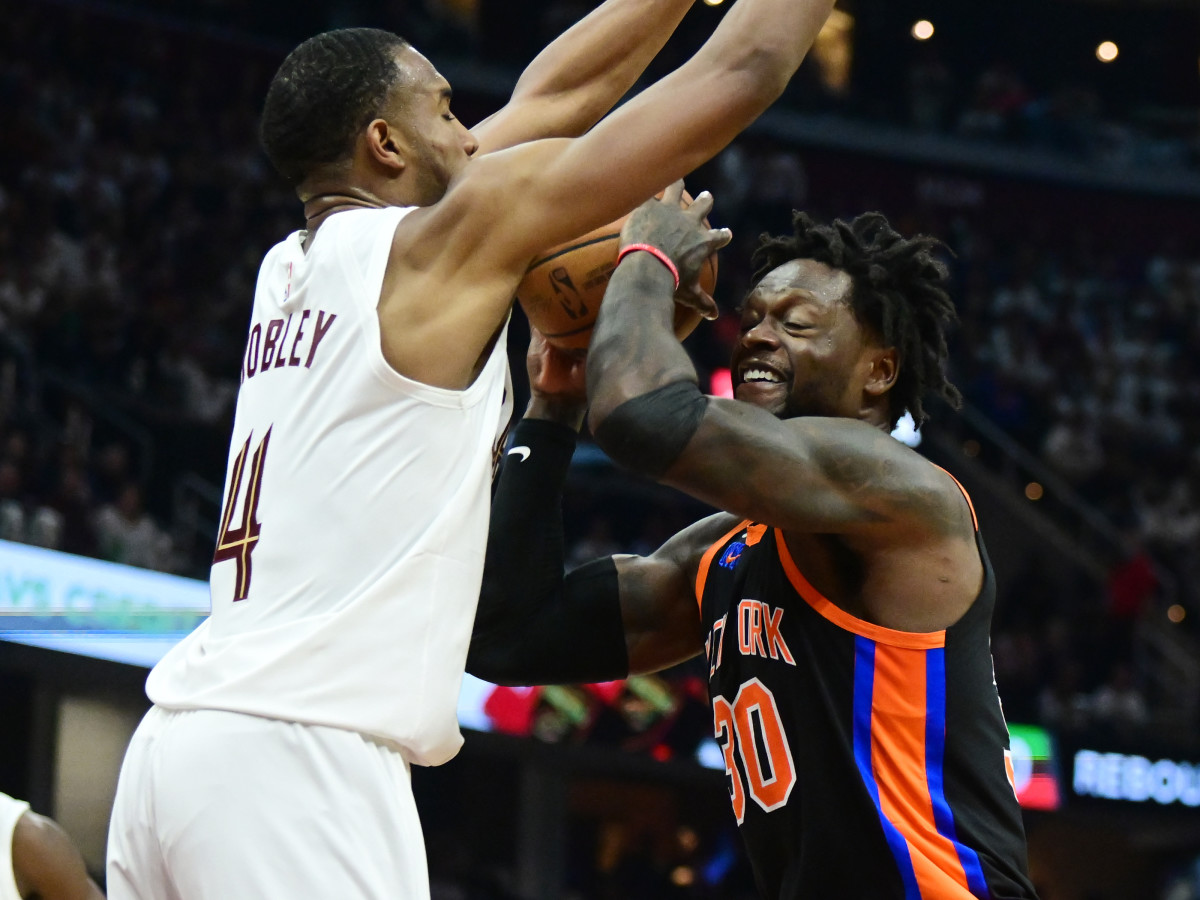Cavaliers’ Defense Clamps Down Against Knicks to Even Series

In the middle of the second quarter of Tuesday’s Game 2 between the Knicks and Cavaliers, TV cameras panned to New York’s Quentin Grimes, who was having the bloody insides of his mouth cleaned up by a team trainer.
The snapshot was a manhandling microcosm for the bullying nature of Cleveland’s defense, which held the Knicks to just 17 points in the period and 39 in the first half. Before halftime alone, the Cavs forced 14 turnovers—more than New York coughed up per game during the regular season—lifting them to a dominant 107–90 victory to even the series at one win each.
Cleveland’s comfortable victory was a haymaker to match the one the Knicks landed in Game 1, when Julius Randle, Josh Hart and Mitchell Robinson threw their weight around at Quicken Loans Arena. New York has more postseason experience, and often looked the aggressor in the series opener. As such, a few Cavs told reporters they’d need to be more physical in Game 2.
With that in mind, Cleveland’s league-leading defense dug in its heels early on, setting effective traps and double teams while also making multiple efforts to get around high screens. Darius Garland and Caris LeVert, in particular, made it difficult for the Knicks to get separation at the point of attack, leaving New York with no way to get any momentum toward the basket. The Knicks went without a basket for almost seven full game minutes, spanning the end of the first quarter and the start of the second.
In the few instances where the Knicks did get the ball in position to score from close range, they generally forced it there, allowing the Cavs’ All-Star caliber big men, Evan Mobley and Jarrett Allen, to load up and swarm with their 7'4" and 7'6" wingspans, respectively. Cleveland was far and away the more physical team in Game 2, imposing its will. The suffocating defensive effort, paired with the Knicks’ overly ambitious isolation efforts at times, led to 18 New York giveaways in all, which went back for 32 Cavalier points in the blowout win.

That J.B. Bickerstaff’s club could shut New York’s water off wasn’t necessarily a shock. After all, the Cavaliers led the NBA in defensive efficiency by surrendering just 109.9 points per 100 possessions. Cleveland also finished with a league-high 28 regular-season contests in which it held opponents under 100 points, logging a dominant 25–3 mark in those games. (On the flip side, the Knicks’ 90 points Tuesday were their second-fewest of the entire campaign. The 39 they had at halftime marked their least points of any game at the break all season.)
Ironically, the Cavs didn’t get much of that stifling defense from starter and stout defender Isaac Okoro, who never saw the court again after picking up a second foul three minutes into the game. His effort followed a tough Game 1 in which he looked like an offensive liability, with the Knicks inching in toward the paint away from him, all but daring the small forward with an iffy scoring touch to shoot from deep.
But the offensive production, from Okoro or anyone else on the Cavs, wasn’t under as harsh a microscope this time. After an uncharacteristically sloppy start as a passer, Garland filled it up in the first half, going off for 26 of his 32 points on the night. His rhythm from outside not only took pressure off superstar Donovan Mitchell (who had 38 points in Game 1), but also lightened the burden on Cleveland’s bench, which underperformed in the opener. LeVert, awful in Game 1, finished with 24 points on 9-for-16 shooting as a reserve Tuesday.
A pair of questions will be answered now heading into Game 3 at Madison Square Garden with an even series this weekend. How will the Cavs, who’ve yet to play a road playoff game with this core of players, fare in a highly hostile environment that’s seeking its first NBA title in 50 years? And, less narratively, how will the Knicks’ key role players respond after an almost impactless showing in Game 2? It’s fair to expect that the Knicks’ stars will fare a bit better—Brunson was 5-for-17, and Randle finished with just one assist and six turnovers—even if they rely heavily on the sorts of isolation looks that the Cavs are among the best at defending. But how will Sixth Man award hopeful Immanuel Quickley bounce back after logging what felt like a quiet 12 points Tuesday? (This followed a mere three-point outing in Game 1.) And how will youngsters RJ Barrett, Obi Toppin and Grimes do after combining for a dismal 7-for-23 shooting night?
The Knicks will hope that being back at their place makes all the difference for their role players. But if you’re the Cavs, the opposite can be just as true: It has to be a good feeling to have a defense that can dominate the way Cleveland’s did Tuesday night. Because a defensive effort like that seems more transferable from one game to the next than a young role player’s jumper.
